#Invacare chairs
Explore tagged Tumblr posts
Text
Experience Exceptional Comfort with Broda Wheelchairs
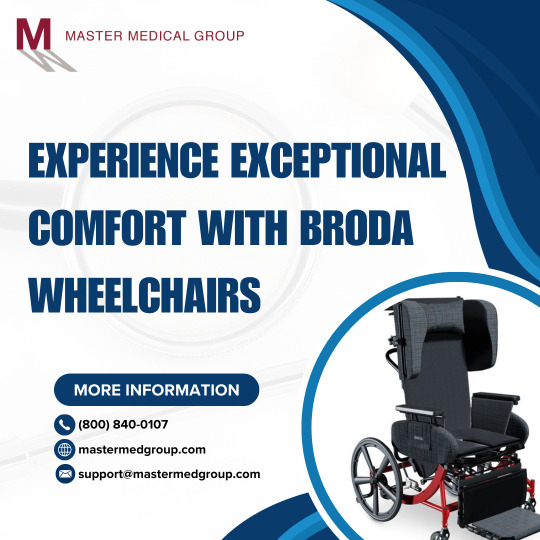
Elevate your mobility experience with Broda Wheelchairs, renowned for their ergonomic design and customizable features. These high-quality wheelchairs prioritize user comfort, offering adjustable tilt, recline, and positioning options to alleviate pressure and promote proper body alignment. Enhance your independence and well-being with Master Medical Group LLC's cutting-edge solutions.
0 notes
Text
I made a zine about adjusting cheaper wheelchairs, after adjusting my NHS wheelchair.
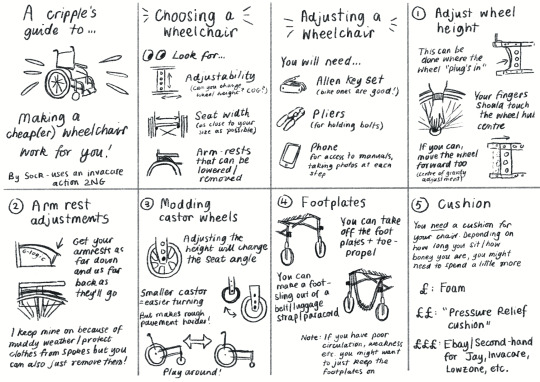
Notes: Your wheelchair ‘service manual’ is a good resource for adjustments! You can often google them. Also, with the wheel adjustments, be prepared to move the breaks. Google how to measure for a wheelchair to find your seat width, and if you want to get extra, look at seat depth. Leg length is usually done by adjusting the footplate height.
Image description and printable version under the ‘read more’ .
Image Description:
An 8 page zine. Both images have the same content but the first one is arranged to be read on a computer. I am going to describe each page.
First page reads “A cripple’s guide to.. making a cheap(er) wheelchair work for you” and in smaller writing “by Sock - who uses an Invacare Action 2NG”. There is a drawing of a wheelchair in the centre.
Page 2 reads “Choosing a wheelchair. Look for adjustability (can you change wheel height? COG?), seat width (as close to your size as possible), and arm rests that can be lowered/removed.” Each item has a small drawing illustrating the point.
Page 3 reads “Adjusting a wheelchair. You will need… Allen key set (bike ones are good!), Pliers (for holding bolts) and Phone (for access to manuals, taking photos at each step.” Each item has a small drawing of it.
Page 4 reads “1. Adjust Wheel height. This can be done where the wheel “plugs in”. Your fingers should touch the wheel hub centre. If you can, move the wheel forward too (centre of gravity adjustment).” There is a small drawing of the wheel base, an arm reaching down to touch the centre of the wheel and a wheel base with an arrow pointing to the right showing it being moved.
Page 5 reads “2. Arm rest adjustments. Get your armrests as far down and as far back as they go. I keep mine on because of muddy weather/to protect clothes from spokes but you can also just remove them!” There is 2 drawings of a rounded and straight arm rest.
Page 6 reads “3. Modding castor wheels. Adjusting the height will change the seat angle. Smaller castor = easier turning, but makes rough pavements harder.” There is a drawing of a tilted chair with big castors and a straight chair with small castors, with a double pointed arrow between, with the caption “Play around!”
Page 7 reads “4. Footplates. You can take the footplates off and toe propel. You can make a foot sling out of a belt/luggage strap/paracord.” Both have an accompanying illustration. Then there is a note saying “if you have poor circulation, weakness, etc. oh might just want to keep the footplates on”.
Page 8 reads “5. Cushion. You need a cushion for your chair. Depending on how long you sit/how bony you are, you might need to spend a little more” then “£: Foam. ££: pressure relief cushion. £££: EBay/second hand for jay, invacare, low zone etc.”
End.
Printable version:
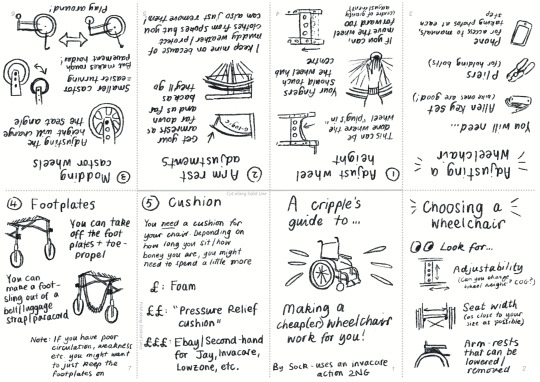
#forsakeofabetterarttag#hope this helps someone#wheelchair#nhs wheelchair#hospital wheelchair#cripplepunk#physically disabled#heds#spoonie#potsie
3K notes
·
View notes
Text
The process of how I bought my wheelchairs.
Someone's asked for help on this, and I've written a couple of really thorough posts that I never published, but here's the short I intended this to be short, but it's not version.
IMPORTANT DISCLAIMER: This is not medical advice. I cannot provide medical advice. I am sharing my own experience, and it should not be used as your only research for this issue. Any time I am saying, "you," please note that it is a style choice to use the second person, and not an indication of giving advice.
Quick note: if your doctor prescribed you a chair, make sure you know what kind of chair was prescribed, and why. The best chair in the world is still awful if it doesn't do what you need.
Also if your insurance will cover a wheelchair then, once you've made sure that your insurance will cover the chair you need, make the smart choice about where you'll buy these things.
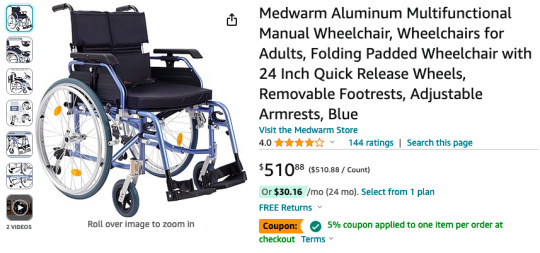
The first time that I was using a wheelchair full time, I was borrowing this one from a friend. This chair is about $500, so when I was buying my first chair for myself, I was looking at that price point. If a chair I was considering was notably more than $500, I knew I could just get my own copy of this chair that I was already comfortable with. The chair that I was borrowing was three years old and had been heavily used, so I was confident in this model's lifespan.
The other big advantage of this is that it ships free with Prime, which meant that it was easy to send to a friend when I was tired of watching her use a inexpensive chair to get around the Disney parks.
But then I went on ebay and learned about the magical world of secondhand wheelchairs. The short version of the story is that a wheelchair can outlive someone's need for it, and so it's not super uncommon to see someone selling an older wheelchair for much less than the chair is new. A lot of the time, these are custom or modular chairs. Instead of a basic chair that's set up to one-size-fits-probably-most, modular and custom chairs have 10+ pages of options to select from in their order form. When you're buying a new custom chair, you pick every option to make sure it's perfect for you. When your goal to buying a used chair is to just get one that's better for you than a Drive Super Sport one-size-fits-hopefully-you chair, the secret to buying on ebay is to find out what features you absolutely need, and then to check the other elements of the chair and see if they will work for you.

Quick note, at the time that I was buying my wheelchair, I actually already owned a wheelchair, and had decided it wasn't going to work for me to use full-time. This is an Invacare Tracer and it was, according to the tag, stolen from a wheelchair rental place in 2010, and according to my mom, stolen from my neighbor's to-be-burned pile in 2019. So if we don't count alleged crime as a cost, this wheelchair was free. This is a great example of a chair that's set up to be one-size-fits-no-one-perfectly.
This wheelchair would be better than nothing, but it's heavy, the wheels are really far back, and it doesn't really fit in my car. The tires have no tread and are pretty worn, so they don't do great for outdoor offroading. All detachable parts of this (armrests, foot rests) had been lost a decade ago, and they're not cheap to replace. I already knew what kind of budget I was willing to spend, and I felt that just using this as my main mode of movement wasn't going to be worth the saving of the $500.
I do still use this wheelchair a LOT in my house, because it's a pain to get my real wheelchair out of my car and into my house (because stairs), but I wouldn't feel confident taking it out on the town unless I have someone to push me.
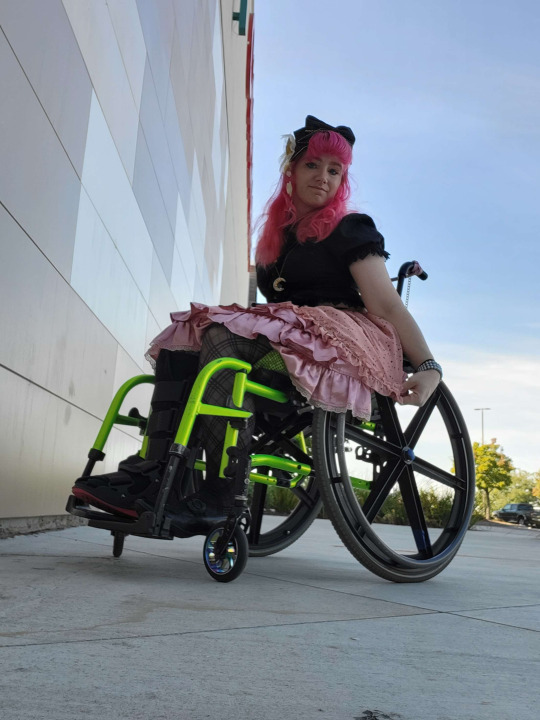
So the secret to buying a wheelchair on ebay is a three step process:
Determine how much money you're able to spend. The best wheelchair in the world isn't going to do you any good if you can't actually get it.
Determine what main features you want in a chair, and look for those.
When you find a chair that has those features at that price, check to see if everything else in the chair works for you.
(Secret step 4: be lucky enough to have someone listing the chair you need).
So I picked this chair (Which is a Quickie 2 Lite) mostly because the Medwarm wheelchair had been a bit too wide for me. This chair was narrower and had a lot of the traits of the Medwarm chair that I'd liked. It folded, had 24" wheels with tread, had feet plates that didn't stick way out in front. I didn't actually know how any of that felt until I had it, because I didn't have experience with multiple wheelchairs. My inexperience gave me a superpower, which was that I didn't need to get so critical of certain traits, because I had no idea what any of that meant.
Shipped and with tax, this was $400. At the time, I just went, "hey, this is like the wheelchair that I want, but without the negative trait of being as wide, and it's $100 less."
The main this about this chair that I learned that I love is that the center of gravity is farther forward than on the Medwarm chair (I believe it's set to +1"). This gave me a lot more power pushing myself. When I was using the Medwarm chair, it wasn't uncommon for me to ask friends to push me long distances. I very rarely needed that in the Quickie2.
But I did have to replace it.
Short version of a long story was that when I went to being a most-time wheelchair user, the seat of my chair got smaller relative to my body. I'd picked a narrower chair because it was easier to navigate the world, but I'd actually picked a chair that was becoming too small for me to fit my Kitten Holding Legs into. I looked into getting a new chair.
So let's talk about the wheelchair that I bought and couldn't use. We learn from our wins and our misses.
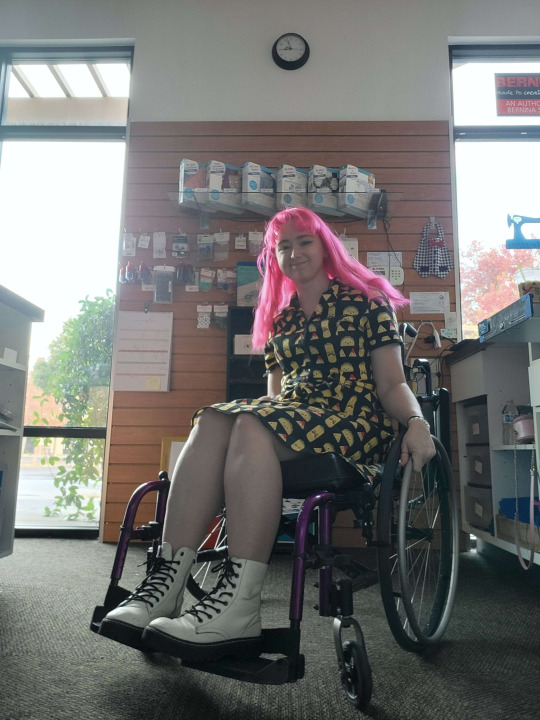
This is a 19" Catalyst 5. There's a few problems with this one for me, but they all sum up to (for me personally) that it had more negative (to me) traits than the Medwarm one, but also was more expensive. I'd picked this one because it looked like it'd be more like my Quickie2 than like the Medwarm, but it just wasn't good for me.
My Quickie2's narrow, so I could put my feet right next to each other. This was the most comfortable way for me to sit. The way that KI measures a Catalyst frame and the way Quickie measures a Quickie 2 frame are different. My 15" frame Quickie 2 had a 14" wide seat, and this 19" Catalyst 5 had a 22" wide frame. The first time that I unfolded it, I knew that it was just too big for me to use comfortably. In addition, I didn't like the solid low-profile tires. I didn't like how far away the wheels were. It also had a really nice quality back, but the back had to be removed to fold the chair, so it was another step to take in and out of my car. It was also about 2" shorter at the seat than my old chair, and I already deal with being too short for my store's counters, so I didn't like losing that height.
So this was a case where I looked for traits that I thought I wanted: folding, wider seat. Then, instead of checking to see if the rest of the traits of the chair were things that I wanted, I just assumed it'd be okay. Personally, it just wasn't the chair for me.
I ended up learning that selling a used wheelchair on ebay is actually pretty easy as well, so the money I lost on this purchase summed up to the cost of a roll of bubble wrap to pack it up to send it to someone who would benefit from it.
When I was looking for my next wheelchair, I had changed what I wanted out of a chair. I knew that I wanted tires with actual tread on them, instead of solid poly smooth tires. I knew that I wanted a wider seat, but not too wide. If it didn't come with a little bit of camber on the wheels (that's where they slant towards the top of the chair), I wanted to be able to add it. I also wanted it to be a minimum of 17" high seat. But the biggest change was that I'd decided that I didn't really need it to be folding.
I drive a hatchback with back seats that can fold down, and I pretty much never have passengers. I decided fuck it, if I'm not driving people, I don't need to keep the seats up, so I could get a non-folding chair and just shove the whole thing in the back without breaking down. Without breaking down the chair. I could still break down. Life is tough sometimes.
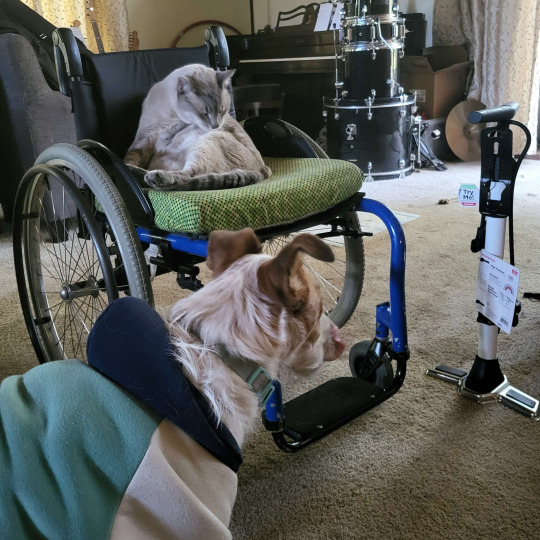
So this is a Quickie GT, which is an old, discontinued model. According to the serial number lookup, it was made in 2009. The good news is that it immediately passed the Cat Test.
When I was looking at this chair, I saw that it was designed for people who push themselves, and would probably be less good for someone who needed other people to push them. This wasn't an issue for me, because I hate being pushed.

(same chair plus two cans of spray paint)
This chair was over the $500 budget (it was $670 with shipping and tax), but this time I'd done enough research to be confident that it'd be a lot better for me than the Medwarm chair. I stuck with Quickie as a brand because I felt like I better understood how they size their seats. The serial number lookup said that this chair was 17" wide, so I was ready to get a 16" seat, and that's what I got. It's got pneumatic tires, which don't just have tread but also roll along the ground like bicycle tires. I love this chair. Instead of two separate foot rests, there's just the one, so I'm a lot more comfortable with how I sit.

It does have the downside of this is the smallest it gets without taking off the wheels. The wheels come off easily and so it's not a big problem, but it's more steps to get it into the car if I don't want to fold back my seats. Also, the front plate doesn't flip up or go away, so if I want to propel myself with my foot I'm a lot more limited.
Once I don't need this anymore, I'm also going to need to either sell it or figure out where to store it. I can keep a folding wheelchair in the back of my closet in case I need it again, but this one will be taking up some space.
For all of the chairs that I got, I was really only searching ebay for a couple of days before the right one at the right price showed up. This is somewhat slanted based on what I need, because certain things do show up more often than others, and at different prices. Wider chairs tend to have less selection and be more expensive, while 12-14" wide chairs are really plentiful.
Let's get together and look at some ebay chairs. We're going to search "wheelchair" and set condition to "used". If you plop the sort system into "price+shipping: lowest first" and then start scrolling until you get past all the wheelchair parts and all the "free local pickup: <location that is in another country>" and into the actual wheelchairs that can ship, you can start checking out the market.
I immediately eliminate anything that doesn't have all the parts, that is too expensive, that is only available for pickup, that doesn't have foot rests, or a few other things. The first one that I saw that I didn't elminate was this.
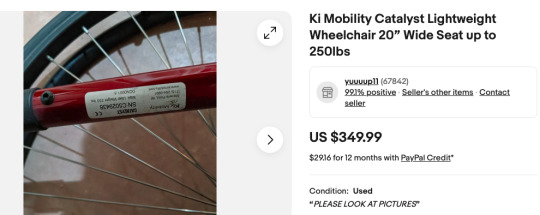
The most important thing from this listing is where they post the serial number.
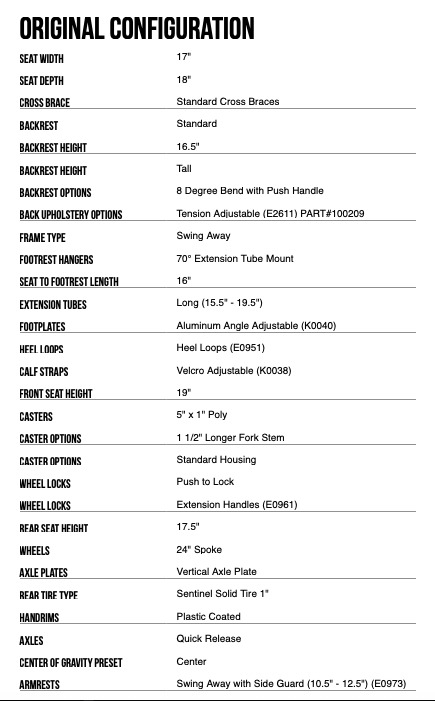
And that's because KI, Sunrise, and Permobil all keep databases of all the serial numbers of all the chairs they have sold.
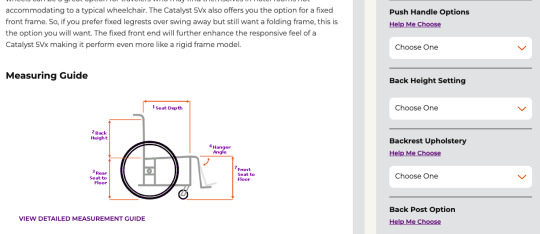
You can now go onto a site that sells that chair and look up what all those things mean. Spinlife sells the Catalyst 5Vx, and if you click "help me choose" on an item listing, it'll usually give you pictures of the different options. For me personally, the draw of this one would be that it's a really good price, and it's roughly set up the same as my default Medwarm chair. I don't like the tires but I do like the side guards and arm rest combo.

This was on a listing for a chair where the serial number wouldn't pull up. I wouldn't consider this one since I can't tell the width or depth when the seller won't list it and Sunrise doesn't have it. I'm just dropping this screenshot because "SELLER NOTE TO SELF" and "BUTT PAD NOT INCLUDED" both made me laugh.
As a quick final note, this is not going to be cheaper than getting a really basic wheelchair off Amazon. However, as someone who has used really basic wheelchairs, getting something upgraded has a whole lot of value. One of the reasons why I really like lolita fashion is that we treasure used things that still have use, and so it's also got some value to me to see if I can get something used that still has use. In my experience, things got better when I tried to get something used. If you do want a really basic chair, it might still be worth it to check if they're available for nearby pickup. Plopping my location into "free local pickup within 30 miles" offers me a basic Drive chair for $20. It's reusing something instead of having to throw it away, and it's also $20. Can't argue with $20.
Anyway, that's half diary entry and half possible advice.
70 notes
·
View notes
Text

Wheel chair decorations!
ID: the back of a wheel chair. There is a patch on the left hand side that is white with red text that reads "support trans rights and trans wrong" A trans symbol stands above the text. There is another patch that says the brand name "Invacare". Three pins are on the right hand side. One is rainbow and has the pronouns he/they on it. Another reads "free people read freely". The last pin is a blue person with a yellow plus sign next to it. End ID
3 notes
·
View notes
Photo
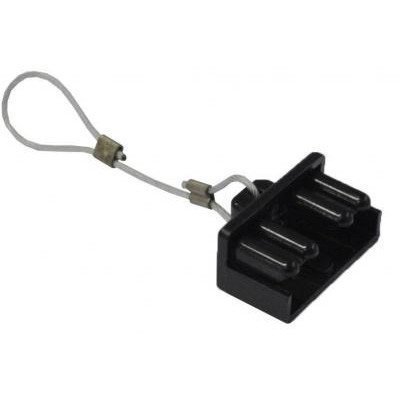
Power wheelchair battery isolator for air travel
Immobilise electrical mobility equipment using two Anderson Connector end cap – ideal for air travel, the Anderson Connector is an economical and practical way to ensure your power chair or electrical mobility scooter is immobilised whilst in-flight. See below for product description below for details of how to use.
Available in 4 different sizes – fits most chairs, check your required plug size.
50A – May come in black or red
120A
175A
350A
The Aviation Authority now requires you to immobile electrical mobility equipment as standard, so it is important that you equip your wheelchair with an immobilisation device to ensure you can travel undisrupted.
This pair of two Anderson Connector covers fit internally to the SB-50, SB-175 and SB-350 wheelchair batteries, and features a wire lanyard which can be attached to the chair to avoid getting lost when not in use.
If these do not fit your chair you may return them for a refund.
Pack includes two caps, which fit most of the popular wheelchair batteries (eg Invacare).
Most airlines now ask power chair users to isolate the battery on their electric wheelchair before take off. The best and easiest way to do this is to plug in these caps. You need to disconnect the battery by disconnecting the two black leads as shown. The two caps supplied then fit safely and securely onto these ends.
When you have fitted them you can hand your chair over to the airport boarding staff at check-in or just before take-off. If you don't use these caps the airport staff may wrap the plugs with tape. This is very difficult to get off at the other end and may even damage your chair.
It was a lovely Easyjet steward who opened the powerchair to d/c the battery for me. All airport staff did was try to yank secure wires out!
— Slay Belle (@notwaving) July 2, 2016
http://disability-health-shop.myshopify.com/products/power-wheelchair-battery-isolator-for-air-travel
#Power chair isolators#Battery caps for wheelchair on flights#Air travel with a wheelchair#Isolating a wheelchair battery#Hi
3 notes
·
View notes
Text
Important Guide to Choosing the Right Phlebotomist Chair: Comfort, Functionality, and Best Options
Essential Guide to choosing teh Right Phlebotomist chair: Comfort, Functionality, and Best Options
choosing the right phlebotomist chair is crucial for both the safety of patients and the comfort of healthcare professionals. With the increasing demand for blood collection, it’s essential to invest in a chair that meets ergonomic standards, offers sufficient adjustability, and enhances the overall patient experience. In this guide, we will delve into various aspects of selecting the perfect phlebotomist chair, examining comfort, functionality, and the best options available on the market.
Why Is the right Phlebotomist chair Significant?
The right phlebotomist chair plays a vital role in:
Minimizing patient discomfort and anxiety.
Ensuring optimal working conditions for the phlebotomist.
Reducing the risk of injuries to both patients and staff.
Key Features to Consider in a phlebotomist Chair
1. Comfort
Comfort is paramount for both the patient being drawn and the phlebotomist performing the procedure. Here are a few features that contribute to comfort:
Padded Seats: A well-cushioned seat can significantly reduce discomfort during extended procedures.
Adjustable Height: The chair should be easily adjustable to suit different patient heights and the phlebotomist’s working posture.
Arm Support: Chairs with adequate armrests help patients feel more secure during blood draws, preventing involuntary movement.
2. Functionality
Besides comfort, functionality is essential. Here’s what to look for:
Swiveling Capability: A chair that swivels allows for easier access to various parts of the arm.
Easy Clean Materials: Chairs made from materials that are easy to disinfect are crucial in maintaining a hygienic environment.
Stable Base: The chair should have a stable base to prevent tipping or sliding during the procedure.
3.Portability and Storage
If your practise involves moving chairs between locations, consider the weight and design of the chair. Folding models or those with wheels facilitate mobility while saving space.
Best options for Phlebotomist Chairs
Chair Model
Features
Price Range
Invacare Patient Chair
Padded seat,Adjustable height,Swivel base
$150 – $200
Rush Comfort chair
High back support,Easy clean material,Armrests
$200 – $300
Harmar Patient Lift Chair
Portable,Lightweight,Foldable design
$250 – $350
Midmark 75 Series Chair
Height adjustable,High weight capacity,Ergonomic design
$800 - $1,200
Benefits of Investing in a Quality Phlebotomist Chair
Enhanced Patient Experience: A comfortable chair can help reduce anxiety,leading to a smoother blood draw.
Increased Efficiency: A functional chair minimizes disruptions, enabling faster procedures.
Improved Workplace Safety: quality chairs reduce the risk of injuries and complaints from both patients and staff.
Case Study: The Impact of Ergonomic Chairs in a Blood Donation Facility
A local blood donation center replaced their standard chairs with ergonomic models, resulting in:
30% increase in donor satisfaction ratings.
50% reduction in donation procedure times.
Significant decrease in complaints about discomfort during donations.
Practical Tips for Choosing the Right Chair
Test the chair before purchasing. Sit in it and adjust to get a feel for it’s functionality.
Read customer reviews to gauge the comfort and reliability of the chair.
Consider the chair’s warranty and support options for peace of mind.
First-Hand Experience: Choosing My Office Chair
When selecting a chair for my own practice, I prioritized adjustable height and padded seating. After testing several models, I chose a swiveling chair that also had armrests to enhance patient stability. The result? Patient feedback improved drastically, and my own back pain decreased. It was a win-win for everyone!
Conclusion
Investing in the right phlebotomist chair is crucial for enhancing patient comfort, improving operational efficiency, and ensuring workplace safety. By considering vital features such as comfort, functionality, and portability, you can select a chair that best fits your needs. Use our guide to navigate your options, and remember, the right chair can make a significant difference in the overall experience for both you and your patients!
youtube
https://phlebotomytechnicianschools.net/important-guide-to-choosing-the-right-phlebotomist-chair-comfort-functionality-and-best-options/
0 notes
Text
North America Hospital Bed Market Size, Revenue, End Users And Forecast Till 2030
The North America Hospital Bed Market is expected to grow from US$ 1,083.38 million in 2022 to US$ 1,466.55 million by 2028; it is estimated to grow at a CAGR of 5.2% from 2022 to 2028.
Growing Preference for Highly Equipped Hospital Bed with Innovative Features
According to a report by the National Institute of Health (NIH), there is a high demand for equipped, facilitated bed, which help prevent other physiological complications among patients, which include bedsores. According to the Mayo Foundation for Medical Education and Research (MFMER) report, a patient suffering from bedsores has medical conditions limiting the ability to change positions or cause them to spend most of their time in a bed or chair. For example, bedsores fall into several stages based on depth, severity, and other characteristics such as the degree of skin and tissue damage ranging from changes in skin color to a severe injury involving muscle and bone. However, the development of information technology (IT) in healthcare, i.e., healthcare IT based medical equipment’s such as smart hospital bed, involving the use of wireless sensor networks (WSNs), has resulted in easy and quick service acting as a solution to prevent bedsores in motionless and disabled patients. With simple applications (apps), hospital bed has been transformed into highly networked appliances, which are categorized as Class 2 Medical Devices seeking electronic intelligence. For example, modern hospital bed is equipped with a monitor screen that shows the health status of patients and enables remote transmission of data to the nurse station.
Grab PDF To Know More @ https://www.businessmarketinsights.com/sample/BMIRE00027529
Market Overview
The North America hospital bed market is segmented in the US, Canada, and Mexico. The growth of the market in North America is attributed to the increasing adoption of healthcare smart beds in acute care or long-term care facilities. For example, the Harvard Medical School reveals in a published study that using respiratory rate sensing technology and heart-rate sensing technology, when incorporated in hospital bed such as bedide monitors and EarlySense's under-the-mattress, helps reduce such events among the patients by 86%. Such aforementioned factors are responsible for the growth of the hospital bed market in North America. The US has the highest rates of intensive care beds among high-income countries and the highest overall hospital capacity in North America.
North America Hospital Bed Strategic Insights
Strategic insights for the North America Hospital Bed provides data-driven analysis of the industry landscape, including current trends, key players, and regional nuances. These insights offer actionable recommendations, enabling readers to differentiate themselves from competitors by identifying untapped segments or developing unique value propositions. Leveraging data analytics, these insights help industry players anticipate the market shifts, whether investors, manufacturers, or other stakeholders. A future-oriented perspective is essential, helping stakeholders anticipate market shifts and position themselves for long-term success in this dynamic region. Ultimately, effective strategic insights empower readers to make informed decisions that drive profitability and achieve their business objectives within the market.
Market leaders and key company profiles
Hill Rom Holding inc. (Baxter)
Stryker Corporation
Arjo Medical Devices
Invacare Corporation
Paramount Bed Holdings Co., Ltd.
GF Health Products Inc.
Malvestio Spa
Span America (Savaria Corporation)
Savion Industries
STIEGELMEYER GMBH & CO.KG
North America Hospital bed market Segmentation
The North America hospital bed market is segmented on the basis of type, usage, application, end user, and country. Based on type, the market is segmented into semi-electric bed, electric bed, and manual bed. The semi-electric bed segment held the largest market share in 2022.
Based on usage, the market is segmented into acute care bed, long-term care bed, psychiatric care bed, and others. The acute care bed segment held the largest market share in 2022. Based on application, the market is bifurcated into non-intensive care bed and intensive care bed. The non-intensive care bed segment held a larger market share in 2022. Based on end user, the market is categorized into hospitals & clinics, elderly care facilities, ambulatory surgical centers, and home care settings.
About Us:
Business Market Insights is a market research platform that provides subscription service for industry and company reports. Our research team has extensive professional expertise in domains such as Electronics & Semiconductor; Aerospace & Defence; Automotive & Transportation; Energy & Power; Healthcare; Manufacturing & Construction; Food & Beverages; Chemicals & Materials; and Technology, Media, & Telecommunications.
0 notes
Text
🚻 Global Portable Commode Chairs Market to Reach $1.43 Billion by 2035, Driven by Aging Population & Home Healthcare Demand
Industry revenue for Portable Commode Chairs is forecast to climb to $1,432.0 million by 2035, up from $694.5 million in 2024. This reflects a compound annual growth rate (CAGR) of 6.8% between 2024 and 2035.
Detailed Analysis - https://datastringconsulting.com/industry-analysis/portable-commode-chairs-market-research-report
Portable commode chairs play a pivotal role in supporting users with limited mobility, and they are widely used across home care, hospitals, assisted living facilities, and travel applications. The report highlights revenue expansion opportunities segmented by Product Type, Material, End-User, Seat Design, and Functional Capacity, with detailed forecasts through 2035.
🏥 Competitive Landscape & Market Leadership
The market remains highly competitive, featuring leading players such as:
Drive Medical
Invacare Corporation
Medline Industries Inc.
Carex Health Brands
NOVA Medical Products
Duro-Med
Cardinal Health
Healthline Trading LLC
TFI Healthcare
Graham-Field Health Products Inc.
Karman Healthcare
DMI Basic Steel
Growth in this space is being propelled by the global aging demographic, increased focus on mobility aid innovation, and greater public awareness of home-based healthcare solutions.
🌍 Key Growth Drivers & Opportunities
Rising demand in elderly care and chronic illness management
Integration of ergonomic and foldable features
Growing adoption in emerging healthcare markets
Countries such as the U.S., UK, Japan, Germany, and Australia will remain at the forefront of demand, while India, Brazil, and South Africa are expected to provide significant growth opportunities due to evolving healthcare systems and consumer needs.
🔄 Regional Dynamics & Supply Chain Insights
North America and Europe are currently the most mature markets, thanks to widespread adoption and strong medical infrastructure. However, high price sensitivity, regulatory standards, and limited awareness in developing economies present market challenges. Supply chains—spanning component sourcing, manufacturing, and distribution—are anticipated to diversify, with localization strategies likely to enhance resilience and market reach.
📈 About DataString Consulting
DataString Consulting delivers end-to-end research and strategic advisory solutions for businesses across B2B and B2C verticals. With more than 30 years of combined experience, our team continuously monitors high-growth segments across 15+ industries globally. We specialize in market intelligence, trend forecasting, opportunity assessments, and custom solutions to help organizations make informed decisions.
#Portable Commode Chairs Market#Mobility Aid Market Trends#Elderly Care Equipment#Home Healthcare Devices#Commode Chair Manufacturers#Assisted Living Equipment#Medical Mobility Solutions#Healthcare Equipment Forecast 2035#Portable Toileting Solutions#Geriatric Medical Devices#Folding Commode Chairs#North America Medical Equipment Market#Aging Population Healthcare Trends#DataString Market Intelligence
0 notes
Text
Patient Handling Equipment Market: Market Analysis and Future Trends 2024-2032

The Patient Handling Equipment Market size was estimated at USD 10.94 billion in 2023 and is expected to reach USD 17.85 billion by 2031 at a CAGR of 6.3% during the forecast period of 2024-2031.
Get Free Sample Report @ https://www.snsinsider.com/sample-request/3371
Regional Analysis
The market for patient handling equipment is experiencing significant growth across various regions:
North America: The presence of advanced healthcare infrastructure and stringent safety regulations contributes to substantial market share.
Europe: Government initiatives promoting caregiver safety and a growing elderly population drive demand for patient handling solutions.
Asia-Pacific: Rapid economic growth, expanding healthcare sectors, and large populations in countries like China and India present significant growth opportunities for market players.
Market Segmentation
The patient handling equipment market is segmented based on type and end user:
By Type:
Patient Transfer Devices
Patient Lifts
Slings
Air-assisted Lateral Transfer Mattresses
Medical Beds
Mobility Devices
Bathroom and Toilet Assist Equipment
Stretchers and Transport Chairs
By End User:
Hospitals
Home-care Settings
Other End Users
Key Players
The major players are Invacare Corporation, Sunrise Medical (US) LLC, Permobil AB, Medline Industries Inc, Yuwell-Jiangsu Yuyue medical equipment & supply Co. Ltd., Ottobock SE & Co KGaA, Pride Mobility Products Corporation, MEYRA GmbH, Hoveround Corporation, MATSUNAGA MANUFACTORY Co. Ltd., Ki Mobility, Etac AB and others
Key Points
Implementation of government regulations ensures caregiver safety during manual lifting procedures.
A significant increase in hospital admissions fuels the demand for patient handling equipment.
The growing elderly and obese populations necessitate advanced patient handling solutions.
Rising demand for home healthcare services presents new market opportunities.
Future Scope
The patient handling equipment market is poised for continued growth, driven by technological advancements and increasing awareness about caregiver safety. The expansion of healthcare infrastructure in emerging economies and the rising preference for home healthcare services are expected to create new avenues for market players. Additionally, the development of innovative, user-friendly equipment will cater to the evolving needs of both patients and caregivers.
Conclusion
In conclusion, the patient handling equipment market is on a robust growth trajectory, supported by demographic shifts, regulatory frameworks, and technological innovations. Stakeholders in this industry should focus on product development, strategic collaborations, and market expansion to capitalize on the emerging opportunities in this dynamic landscape.
Contact Us: Jagney Dave - Vice President of Client Engagement Phone: +1-315 636 4242 (US) | +44- 20 3290 5010 (UK)
Other Related Reports:
Smart Healthcare Market
Optometry Equipment Market
Post Traumatic Stress Disorder Treatment Market
MRI Guided Neurosurgical Ablation Market
#Patient Handling Equipment Market#Patient Handling Equipment Market Share#Patient Handling Equipment Market Size#Patient Handling Equipment Market Trends
0 notes
Text
Supporting Care: Economic and Technological Trends in Patient Handling Equipment
The global patient handling equipment market is expected to reach USD 28.2 billion by 2030, according to a new report by Grand View Research, Inc., growing at CAGR of 6.6% from 2024 to 2030. The upsurge in the demand for products, such as slings, lifts, powered electric wheelchairs, due to the high risk of physical injuries in the manual lifting of heavy loads is a key growth driver of the patient handling equipment market. In addition, the growing prevalence of injuries, such as lower back pain, musculoskeletal disorders (MSDs), etc., is expected to boost growth in this sector. These injuries are avoidable by practicing safe patient handling guidelines and using equipment for the same.
Associated advantages and availability of improved products such as prime Transport Chairs (TC), temperature management systems, and patient transfer solutions, which offer safe, comfortable, and dignified transfer are the factors anticipated to provide lucrative growth to this sector in the near future.
Increasing incidences of Non-communicable Diseases (NCD), such as diabetes, asthma, cancer, stroke, etc., requiring patient handling equipment in homecare settings, hospitals, and intensive care units are further expected to boost market growth over the forecast period.
Patient Handling Equipment Market Report Highlights
Wheelchairs have registered for the dominant market share, with 28.7% in 2023. The growing aged population and people with reduced mobility seek wheelchairs as a primary supportive mobility solution.
Bariatric care has dominated the market in 2023 owing to the increasing senior population and obesity rates. Bariatric patients require specialized handling solutions due to their weight and mobility challenges.
Hospitals secured the dominant market share with 46.4% in 2023 due to the geriatric population's increasing prevalence that necessitates specialized patient handling equipment.
The North America patient handling equipment held the dominant market share, with 36.6% in 2023, owing to strict safety regulations implemented by healthcare institutions that ensure patient safety during handling and transport.
Curious about the Patient Handling Equipment Market? Get a FREE sample copy of the full report and gain valuable insights.
Patient Handling Equipment Market Segmentation
Grand View Research has segmented the global patient handling equipment market on the basis of type, application, end use, and region:
Patient Handling Equipment Type Outlook (Revenue, USD Million, 2018 - 2030)
Patient Lifts
Medical Lifting Slings
Wheelchairs
Transport Chairs
Stretchers
Medical Beds
Bathroom & Toilet Assist Devices
Patient Handling Equipment Application Outlook (Revenue, USD Million, 2018 - 2030)
Bariatric Care
Acute Care
Long-term Care
Rehabilitation
Others
Patient Handling Equipment End Use Outlook (Revenue, USD Million, 2018 - 2030)
Hospitals
Homecare
Elederly Care
Other Healthcare
Patient Handling Equipment Regional Outlook (Revenue, USD Million, 2018 - 2030)
North America
US
Canada
Mexico
Europe
Germany
UK
France
Italy
Spain
Denmark
Sweden
Norway
Asia Pacific
China
Japan
India
Australia
South Korea
Thailand
Latin America
Brazil
Argentina
Middle East and Africa (MEA)
South Africa
Saudi Arabia
UAE
Kuwait
Key Players of Patient Handling Equipment Market
Stryker Corporation
Hill-Rom Holdings, Inc.,
Invacare Corporation
Getinge Group
ArjoHuntleigh, Inc.,
Joerns Healthcare, Inc.,
Stiegelmeyer, Inc.
Benmor Medical Ltd.
Prism Medical Ltd.
Etac Ltd.
Mangar International Ltd.
Linet Americas, Inc.
Order a free sample PDF of the Patient Handling Equipment Market Intelligence Study, published by Grand View Research.
0 notes
Text
Reliable Mobility Solutions: Invacare Chairs
Discover the perfect mobility solution with Master Medical Group LLC’s Invacare chairs. Known for their durability and innovative design, these chairs offer superior maneuverability, adjustable features, and robust construction to accommodate diverse needs. Experience the freedom of movement and independence with Master Medical Group LLC's trusted range of wheelchairs and transport chairs.
0 notes
Text
Leading 10 Phlebotomy Chairs for Sale: Comfort, Quality, and Affordability You Can Trust
Top 10 Phlebotomy Chairs for Sale: Comfort, Quality, and Affordability You can Trust
Top 10 Phlebotomy Chairs for Sale: Comfort, Quality, and Affordability You Can Trust
Finding the right phlebotomy chair is essential for any medical practice, as it directly impacts patient comfort and procedure efficiency. With so many options available, choosing the best one can be overwhelming. To simplify your search, we have compiled a list of the Top 10 Phlebotomy Chairs for Sale that balance comfort, quality, and affordability.
Why Invest in a Good Phlebotomy Chair?
Comfort for Patients: A well-designed chair ensures patients are relaxed, reducing anxiety during blood draws.
Ergonomics for Staff: Comfortable seating helps healthcare professionals perform their duties effectively without straining their bodies.
Durability: High-quality chairs stand the test of time,providing long-term value for your investment.
Easy Maintenance: Good chairs frequently enough come with materials that are easy to clean and maintain, ensuring a hygienic habitat.
Top 10 Phlebotomy chairs for Sale
Chair Model
Comfort rating
Price Range
Key features
1.Medline Reclining Phlebotomy Chair
9/10
$$$
Reclining back, height adjustable, vinyl upholstery.
2. Rika Phlebotomy Chair
8/10
$$
Sleek design, detachable armrests, durable upholstery.
3. Drive Medical Phlebotomy Chair
8.5/10
$$$
Easy mobility, adjustable leg rest, sturdy build.
4. Invacare Phlebotomy Chair
9/10
$$$
Secure height adjustment, comfortable padding, wide base.
5. chiroform Phlebotomy Chair
7.5/10
$$
Lightweight, user-amiable, chic aesthetic.
6. O2 Medical Phlebotomy Chair
8/10
$$$
Multi-position capability, breathable fabric, easy to clean.
7. ProMedica Phlebotomy Chair
9/10
$$$
Optimal lumbar support, recliner feature, non-slip base.
8. Gendron Phlebotomy Chair
8.5/10
$$$
Electric height adjustment, soft cushioning, modern design.
9.healthcraft Phlebotomy Chair
9/10
$$$
Customizable settings, robust frame, easy assembly.
10. Amsco Phlebotomy Chair
8/10
$$
Sleek profile, tough upholstery, resilient construction.
Benefits of a Quality Phlebotomy Chair
Investing in a quality phlebotomy chair provides several benefits that enhance both patient and staff experiences:
Increased Patient Satisfaction: Comfortable seating leads to a more positive experience for patients.
Efficiency: adjustable features allow staff to work more effectively, minimizing time spent on setup.
Safety: Non-slip surfaces and stable designs reduce the risk of accidents.
Practical Tips for Purchasing a Phlebotomy Chair
When choosing a phlebotomy chair, consider the following tips:
Assess Your Space: Ensure the chair fits comfortably in your medical setting without overcrowding.
Test Comfort Levels: If possible, test the chair beforehand to gauge comfort for both patients and staff.
Check for warranty: Look for chairs offering warranties as a sign of quality assurance.
Read Customer reviews: Insights from other users can provide valuable facts regarding performance and durability.
Case Studies: First-Hand Experiences with Phlebotomy Chairs
To provide a more practical perspective, here are a couple of testimonials from medical professionals:
Dr. Anne Smith, Phlebotomist: “Since switching to the Medline Reclining Phlebotomy chair, my patients find it much easier to relax during blood draws.The adjustable settings also make it easier for me, enhancing my workflow.”
Nurse John Doe,Clinic Manager: “The O2 Medical Phlebotomy Chair has been a game-changer for our clinic. Easy to clean and very comfortable, our patient satisfaction ratings have substantially improved.”
Conclusion
Choosing the right phlebotomy chair is crucial for any medical practice dedicated to providing high-quality patient care. The Top 10 Phlebotomy Chairs for Sale listed above have been carefully selected based on their comfort, quality, and affordability. by investing in a high-quality chair, you can enhance patient experiences, improve staff efficiency, and ultimately, foster a more productive environment in your practice.
Remember to consider your specific needs and budget when making your choice. With the right information and a focus on what matters most,you can find a phlebotomy chair that perfectly suits your practice now and in the future.
https://phlebotomytrainingcenter.net/leading-10-phlebotomy-chairs-for-sale-comfort-quality-and-affordability-you-can-trust/
0 notes
Text
Ambulatory Equipment Market Growth: Share, Value, Size, Scope, and Insights
"Ambulatory Equipment Market Size And Forecast by 2030
The Ambulatory Equipment Market is an evolving industry that holds significant potential across various sectors, driven by advancements in technology, shifting consumer preferences, and growing demand for innovative solutions. With a robust ecosystem of players and a dynamic competitive landscape, the market offers ample opportunities for growth and value creation. This report delves into the size, share, and scope of the Ambulatory Equipment Market, providing a detailed analysis of its current state and future outlook.
Data Bridge Market Research analyses that the Global Ambulatory Equipment Market which was USD 545 Billion in 2022 is expected to reach USD 849.17 Million by 2030 and is expected to undergo a CAGR of 5.70% during the forecast period of 2022 to 2030
Get a Sample PDF of Report - https://www.databridgemarketresearch.com/request-a-sample/?dbmr=global-ambulatory-equipment-market
Which are the top companies operating in the Ambulatory Equipment Market?
The Top 10 Companies in Ambulatory Equipment Market include leading industry players that have established a strong presence through innovation, quality products, and strategic partnerships. These companies dominate the market by leveraging advanced technologies, extensive distribution networks, and a deep understanding of consumer needs. Their market leadership is often driven by significant investments in research and development, as well as their ability to adapt to changing market trends and consumer demands.
**Segments**
- **Product Type**: The ambulatory equipment market can be segmented based on product type into mobility aids, patient transfer equipment, medical furniture, monitors, and others. Mobility aids include canes, crutches, wheelchairs, and walkers. Patient transfer equipment consists of lifts, slings, and transfer boards. Medical furniture includes beds, chairs, and tables specifically designed for patient use. Monitors encompass vital sign monitors, ECG machines, and blood pressure monitors among others.
- **End User**: End users for ambulatory equipment include hospitals, clinics, ambulatory surgical centers, home healthcare settings, and others. Hospitals are the major end users due to the large patient pool requiring ambulatory care. However, the demand for ambulatory equipment in home healthcare settings is also increasing as patients prefer to receive care in the comfort of their homes.
- **Application**: The market can be further segmented based on application into orthopedics, neurology, cardiology, oncology, and others. Orthopedic applications dominate the market due to the high prevalence of orthopedic conditions requiring ambulatory assistance. Neurology and cardiology applications are also significant segments due to the need for continuous monitoring and support for patients with neurological and cardiac disorders.
**Market Players**
- **Invacare Corporation**: Invacare offers a wide range of ambulatory equipment including wheelchairs, walkers, and patient lifts. The company focuses on innovative designs and functionality to meet the diverse needs of patients and healthcare providers.
- **Stryker Corporation**: Stryker is a key player in the ambulatory equipment market, providing products such as hospital beds, stretchers, and transfer chairs. The company emphasizes quality and durability in its products to ensure patient safety and comfort.
- **Drive DeVilbiss Healthcare**: Drive DeVilbiss Healthcare is known for its mobility aids and patient transfer equipment. The company's products are designed for ease of use and reliability, making them popular choices among healthcare facilities and individuals.
- **GF Health Products, Inc.**: GF Health Products offers a range of medical furniture and monitors for ambulatory care settings. The company focuses on ergonomic designs and user-friendly features to enhance patient care and comfort.
The global ambulatory equipment market is driven by factors such as the increasing geriatric population, rising prevalence of chronic diseases, and growing demand for home healthcare services. Technological advancements in ambulatory equipment, coupled with a shift towards personalized healthcare solutions, are expected to further propel market growth. However, challenges such as high costs of advanced ambulatory equipment and reimbursement issues in certain regions may hinder market expansion. Overall, the market is characterized by intense competition among key players striving to innovate and cater to evolving healthcare needs.
The global ambulatory equipment market is experiencing significant growth driven by various factors such as the increasing geriatric population, rising prevalence of chronic diseases, and the growing demand for home healthcare services. As the world population ages, the need for ambulatory equipment to assist in everyday mobility and care is on the rise. The shift towards personalized healthcare solutions is also shaping the market, with patients preferring customized and convenient healthcare options. Technological advancements in ambulatory equipment have led to the development of innovative products that enhance patient comfort and improve healthcare outcomes. Features such as remote monitoring capabilities, real-time data capture, and smart functionalities are becoming more common in ambulatory equipment, providing patients and healthcare providers with valuable insights and support.
One emerging trend in the ambulatory equipment market is the focus on lightweight and portable designs for increased convenience and ease of use. Manufacturers are incorporating materials that are not only durable and reliable but also lightweight for better mobility options. This trend caters to the needs of patients who require ambulatory assistance while on the go, enabling them to maintain their independence and quality of life. Additionally, customization and personalization of ambulatory equipment are gaining traction, with more companies offering tailored solutions to meet the specific needs of individual patients. Customized products not only improve patient comfort but also enhance overall satisfaction and compliance with healthcare protocols.
Another key driver of market growth is the rising demand for ambulatory equipment in home healthcare settings. With the preference for receiving care in the comfort of one's home increasing, the need for ambulatory aids and medical furniture for home use is on the rise. Home healthcare settings offer a more personalized and patient-centric approach to care, contributing to better health outcomes and improved quality of life for patients. As a result, manufacturers of ambulatory equipment are focusing on developing products that are suitable for home use, with features that promote comfort, safety, and ease of use in a non-clinical environment.
Despite the positive growth trajectory, the ambulatory equipment market faces challenges that may impact market expansion. High costs associated with advanced ambulatory equipment could limit adoption, especially in regions with limited healthcare budgets or reimbursement issues. Additionally, regulatory hurdles and varying healthcare policies across different regions may pose obstacles to market growth and expansion. To address these challenges, market players need to focus on cost-effective solutions, regulatory compliance, and strategic partnerships to overcome barriers and capitalize on emerging opportunities in the global ambulatory equipment market.**Segments**
Global Ambulatory Equipment Market, By Equipment (Transfer Boards, Canes, Crutches, Walkers, Wheelchairs, Support Surfaces), Specialty (Single Specialty, Multi-Specialty), Ownership (Hospital Only, Physician Only, Corporation Only, Physician and Corporation, Hospital, and Corporation), Center Type (Hospital-Based, Free-Standing) – Industry Trends and Forecast to 2030.
The global ambulatory equipment market is witnessing significant growth and evolution, driven by diverse factors such as the increasing aging population, surging prevalence of chronic diseases, and escalating demand for home healthcare services. As the need for ambulatory equipment across various healthcare settings continues to rise, the market is experiencing a shift towards more advanced, personalized, and convenient solutions to meet evolving patient needs and enhance healthcare outcomes. Technological advancements in ambulatory equipment are playing a crucial role in shaping the market landscape, with features like remote monitoring, real-time data capture, and smart functionalities becoming increasingly prevalent to provide enhanced patient care and support.
One key trend shaping the ambulatory equipment market is the emphasis on lightweight and portable designs to enhance convenience and ease of use for patients. Manufacturers are increasingly focusing on utilizing durable yet lightweight materials in their products to offer improved mobility options to patients requiring ambulatory assistance. The trend towards customization and personalization of ambulatory equipment is also gaining momentum, with companies providing tailored solutions to address individual patient requirements. Customized products not only enhance patient comfort but also contribute to higher levels of satisfaction and adherence to healthcare protocols.
The growing demand for ambulatory equipment in home healthcare settings is another significant driver of market expansion. With an increasing preference for receiving care in home environments, the need for ambulatory aids and medical furniture designed for home use is on the rise. Home healthcare settings offer a patient-centered approach to care, leading to better health outcomes and improved quality of life for individuals. Manufacturers are thus developing products with features that promote comfort, safety, and ease of use in non-clinical settings, catering to the specific needs of patients receiving care at home.
Despite the positive growth trajectory, the ambulatory equipment market faces challenges that could potentially hinder its expansion. High costs associated with advanced ambulatory equipment may limit adoption rates, particularly in regions with constrained healthcare budgets or reimbursement issues. Regulatory complexities and varying healthcare policies across different regions also present barriers to market growth. To overcome these challenges and capitalize on emerging opportunities, market players need to focus on providing cost-effective solutions, ensuring regulatory compliance, and establishing strategic partnerships to advance in the global ambulatory equipment market.
**Market Players**
- Doubek Medical Supply (U.S.) - McKesson Medical-Surgical Inc (U.S.) - Angel Medical Supply (U.S.) - AOSS Medical Supply, LLC (U.S.) - Kights Medical (U.S.) - Adventist Health (U.S.) - Geriatric Medical and Surgical Supply, Inc. (U.S.) - Aetna Inc. (U.S.) - Distribution Unlimited (U.K.) - Air-Caire Home Medical Equipment & Supplies (U.S.) - Scrip Inc. (U.S.) - Rehab and Mobility Systems, LLC, (U.S.) - MTSHS (U.S.) - Coastline Medical Solutions (U.S.) - SupremeMed (U.S.) - Invacare Corporation (U.S.) - Hill-Rom Holdings, Inc (U.S.) - Stryker Corporation (U.S.) - Medtronic plc (Ireland) - Medline Industries, Inc (U.S.)
These market players play a crucial role in driving innovation, meeting diverse customer needs, and shaping the competitive landscape of the ambulatory equipment market. Through product development, strategic collaborations, and a focus on quality and customer satisfaction, these companies contribute to the overall growth and advancement of the global ambulatory equipment market.
Explore Further Details about This Research Ambulatory Equipment Market Report https://www.databridgemarketresearch.com/reports/global-ambulatory-equipment-market
Key Insights from the Global Ambulatory Equipment Market :
Comprehensive Market Overview: The Ambulatory Equipment Market is witnessing strong growth driven by increasing demand and technological advancements.
Industry Trends and Projections: Key trends include automation, sustainability, and a shift towards digital solutions, with a projected CAGR of X%.
Emerging Opportunities: Opportunities are emerging in green technologies, personalized services, and untapped geographical regions.
Focus on R&D: Companies are heavily investing in R&D to drive innovation, especially in AI, IoT, and sustainable solutions.
Leading Player Profiles: Dominant players like Company A and Company B lead the market with robust portfolios and global reach.
Market Composition: The market is fragmented, with a mix of established companies and innovative startups.
Revenue Growth: Revenue in the Ambulatory Equipment Market is steadily increasing, fueled by rising consumer demand and expanding commercial applications.
Commercial Opportunities: Commercial opportunities lie in entering emerging markets, digital expansion, and forming strategic partnerships.
Find Country based languages on reports:
https://www.databridgemarketresearch.com/jp/reports/global-ambulatory-equipment-markethttps://www.databridgemarketresearch.com/zh/reports/global-ambulatory-equipment-markethttps://www.databridgemarketresearch.com/ar/reports/global-ambulatory-equipment-markethttps://www.databridgemarketresearch.com/pt/reports/global-ambulatory-equipment-markethttps://www.databridgemarketresearch.com/de/reports/global-ambulatory-equipment-markethttps://www.databridgemarketresearch.com/fr/reports/global-ambulatory-equipment-markethttps://www.databridgemarketresearch.com/es/reports/global-ambulatory-equipment-markethttps://www.databridgemarketresearch.com/ko/reports/global-ambulatory-equipment-markethttps://www.databridgemarketresearch.com/ru/reports/global-ambulatory-equipment-market
Data Bridge Market Research:
Contact Us:
Data Bridge Market Research
US: +1 614 591 3140
UK: +44 845 154 9652
APAC: +653 1251 975
Email:- [email protected]"
0 notes
Text
Hello!
I have a folding frame Quickie 2 wheelchair. It is a blue frame with black accents. I have lot of patches and pins on it. Feel free to ask questions!
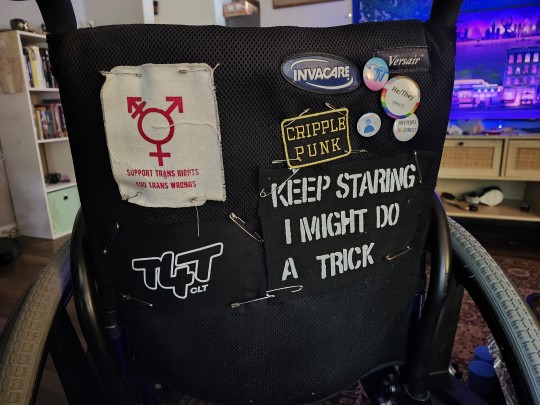
ID: the back of a black and blue wheelchair. There are many pins and patches. From left to right, top to bottom;
1. A white patch with red text and a red gender queer symbol. It reads "Support trans rights and trans wrongs."
2. A black patch with big white text that reads "T4T CLT"
3. A rubbery Invacare patch that came with the chair.
4. A black patch with a yellow border. The text is yellow and reads "Cripple Punk."
5. A large black patch with blocky white text. It reads "Keep staring I might do a trick."
6. A small black patch that says "Versair." This patch also came with the chair
7. A purple, blue, and pink pin that says "T4T."
8. A rainbow pin with the pronouns "He/They" written on it
9. A pin with a blue person and a yellow plus sign beside them.
10. A white pin with the text "Free people read freely." Read Freely is written in rainbow colors
END ID
Disability aid users! I would love to see your aids, if you are consenting to sharing pictures of it that is!
This goes for any mobility aids but also stuff like c-paps, stoma bags, braces, AAC device(s), visual aids - Anything that you haven't found positivity posts for or just wanted others to see (or just wanted to share!)
I know mobility aids get talked about a decent amount, but every aid is important to those that use them! And i'd like to spread more positivity about aids of all kind!
#chris wonder talks#cripple punk#wheelchair#this post has been sitting in my drafts for like a whole year now
112 notes
·
View notes
Text
Leading 10 Phlebotomy Chairs for Sale: Comfort & Efficiency for every single Clinic
# Top 10 Phlebotomy Chairs for Sale: Comfort & Efficiency for Every Clinic
Phlebotomy is an essential part of healthcare that requires both skill and the right equipment. One key piece of equipment that can dramatically affect the quality of care provided is the phlebotomy chair. The best phlebotomy chairs blend comfort, functionality, and efficiency, creating a pleasant experience for both patients and healthcare professionals.
In this article, we will explore the **Top 10 Phlebotomy Chairs for Sale** along with their features, benefits, and practical tips for making the right choice for your clinic.
## Why Choose the Right Phlebotomy Chair?
Selecting the right phlebotomy chair is crucial for the following reasons:
– **Patient comfort**: A well-designed chair can ensure that patients are pleasant while being treated, reducing anxiety and making the process smoother. – **Practitioner Efficiency**: Comfortable chairs allow healthcare professionals to work more effectively, minimizing the strain on their bodies while performing venipuncture. – **Space Utilization**: Well-designed chairs can save space and streamline the workflow in a busy clinic.
## Factors to Consider When Purchasing Phlebotomy Chairs
Before diving into our top picks, let’s consider the essential factors to evaluate when buying phlebotomy chairs:
– **Adjustability**: Chairs that can be adjusted for height and reclining positions help accommodate patients of different sizes and needs. - **Durability**: Look for chairs made from high-quality materials that can withstand daily use. – **Ease of Cleaning**: Vinyl or leather upholstery is preferred for easy sanitation. – **Weight Capacity**: Ensure the chair can support a variety of different patient weights. – **Portability**: Some clinics may benefit from lightweight chairs that can be transported easily.
### Top 10 Phlebotomy Chairs for Sale
Below is a list of the top 10 phlebotomy chairs available for purchase, assessed for comfort and efficiency:
| **Chair Name** | **Description** | **Price Range** | **Adjustability** | **Weight Capacity** | |—————————|——————————————————————-|——————|——————-|———————| | 1. *ProBasics Lumbar Chair* | Ergonomic design with lumbar support and footrest. | $400 – $500 | Yes | 300 lbs | | 2.*Drive Medical Phlebotomy Chair* | Hydraulic lift for easy height adjustment, sturdy base. | $350 – $450 | Yes | 350 lbs | | 3. *Invacare Adjustable Chair* | Soft, cushioned seat with adjustable armrests. | $300 – $400 | Yes | 300 lbs | | 4. *Medline Clinical Chair* | High-density foam cushions for maximum comfort. | $450 - $550 | Yes | 350 lbs | | 5. *Champion Health Travel Chair* | Lightweight and foldable for easy transport.| $220 – $320 | no | 250 lbs | | 6. *Graham-Field Phlebotomy Chair* | Sufficient padding and contoured design for comfort. | $280 – $380 | Yes | 300 lbs | | 7. *MediChoice Reclining Chair* | Reclines for comfort, offering an adjustable footrest. | $400 – $500 | Yes | 350 lbs | | 8. *amsino Phlebotomy Chair* | Portable, with anti-bacterial upholstery for easy cleaning. | $250 – $350 | no | 300 lbs | | 9. *Allegro Medinote Chair* | Designed for children, smaller size with vibrant colors. | $200 – $300 | Yes | 200 lbs | | 10. *Basic Medical Phlebotomy Chair* | Cost-effective design that doesn’t compromise on comfort. | $150 – $250 | no | 250 lbs |
## Benefits of High-Quality Phlebotomy Chairs
When clinics invest in quality phlebotomy chairs,they will experience numerous benefits:
– **improving Patient experience**: Comfort significantly decreases the anxiety some patients feel,leading to a better overall experience. – **Enhancing Efficiency**: Practitioners can operate smoothly with fewer interruptions, speeding up the blood draw process. – **Reducing injury Risks**: Ergonomically designed chairs can help minimize the risk of strain injuries for technicians who perform repetitive tasks.
## Case Study: Streamlining Processes with the Right Chair
*In a mid-sized clinic in Houston, Texas, the implementation of better phlebotomy chairs correlated with a 20% decrease in patient wait times and a 30% increase in overall patient satisfaction.* The clinic upgraded to the *Medline Clinical Chair*, which allowed for better adjustability and comfort.The outcome demonstrated that investing in the right equipment has a direct positive impact on clinical efficiency and patient happiness.
## Practical Tips for Maintaining Phlebotomy Chairs
– **Regular Cleaning**: Ensure that all chairs are cleaned after each patient visit to maintain hygiene standards. – **Check Adjustability Mechanisms**: Monthly inspections help ensure that all adjustable parts function smoothly, extending the chair’s lifespan. - **Padding Replacement**: Keep a lookout for wear and tear; consider replacing upholstery or padding as necessary to maintain comfort levels.
## Personal Experience: What Patients Prefer
As a phlebotomist with over five years of experience,I’ve observed firsthand how chair comfort affects patient compliance. Patients often express appreciation when seated in comfortable, well-cushioned chairs, and the ability to adjust the chair to their preferred height reduces anxiety. The *ProBasics lumbar Chair*, such as, received many positive remarks for its ergonomic design, proving to be a important asset in both comfort and efficiency.
## Conclusion
selecting the right phlebotomy chair goes beyond aesthetics; it is crucial for improving patient experiences and healthcare providers’ efficiency. Investing in one of our top 10 phlebotomy chairs will ensure that your clinic meets today’s demands for comfort, durability, and functionality.
Whether you opt for a lightweight travel chair or a more luxurious reclining model, prioritizing comfort and quality will result in a more satisfied clientele and a more productive workplace.
Remember to analyze your clinic’s unique needs and patient demographics, and review user feedback before making your final decision. Happy chair hunting!
—
This article is structured to provide expansive data while being optimized for search engines with relevant keywords naturally integrated, ensuring visibility for your practice seeking the best phlebotomy chairs in the market.
youtube
https://phlebotomytechnicianschools.org/leading-10-phlebotomy-chairs-for-sale-comfort-efficiency-for-every-single-clinic/
0 notes
Text
Comfort Meets Care: Innovations in the Specialty Medical Chairs Market 💺🩺
Speciality Medical Chairs Market Overview

The Global Speciality Medical Chairs Market has seen continuous development in the past couple of years and is anticipated to grow much further during the forecast period. The exploration introduces a total evaluation of the Speciality Medical Chairs Market and contains Future patterns, Current Growth Factors, mindful sentiments, certainties, chronicled information, and factually bolstered and industry-approved market information.
According to Straits Research, the global Speciality Medical Chairs market size was valued at USD 3.78 Billion in 2021. It is projected to reach from USD XX Billion in 2022 to USD 7.49 Billion by 2030, growing at a CAGR of 7.9% during the forecast period (2022–2030).
After identifying promising candidates, they undergo extensive testing and optimization to enhance their effectiveness, safety, and pharmacokinetic properties. This entire process of Speciality Medical Chairs Market may take several years and necessitates collaboration between scientists from diverse fields such as chemistry, biology, and pharmacology. Irrespective of the challenges encountered during Speciality Medical Chairs Market, it has the potential to revolutionize lives by providing new treatments for various diseases.
Request Sample Report of Global Speciality Medical Chairs Market @ https://straitsresearch.com/report/speciality-medical-chairs-market/request-sample
Competitive Analysis
The report contains an in-depth analysis of the vendor’s profile, including financial health, business units, key business priorities, SWOT, strategies, and views.
Rehab Seating Systems Inc.
A-DEC Inc.
ACTIVEAID Inc.
DentalEZ Inc.
Topcon Medical Systems Inc.
Midmark Corp.
PLANMECA OY
Fresenius SE & Co. KGaA
Hill Laboratories Company
Forest Dental Products Inc.
Dentsply Sirona
Danaher (KaVo Dental GmbH)
Invacare Corporation.
The vendors have been identified based on the portfolio, geographical presence, marketing & distribution channels, revenue generation, and significant R&D investments.
Request Sample Report of Global Speciality Medical Chairs Market @ https://straitsresearch.com/report/speciality-medical-chairs-market/request-sample
0 notes